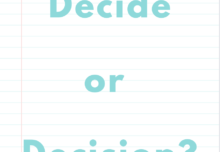Using positive language is a great way to make sentences short and snappy.
At the risk of sounding like a Grinch, this isn’t about being happy and upbeat. Instead, using the positive form is about saying what something is – not what something isn’t.
For example, instead of writing Hillary Clinton did not win the election, write Hillary Clinton lost the election.
The word to look out for is not, as well as the contraction of it such as didn’t or isn’t.
Now, sometimes there’s a good reason to use the negative, such as in a denial or to counteract a positive statement – ie: The plumber said he fixed the leak – but he hadn’t.
Furthermore, not all negative words are equal: for example, never is a stronger word than not and has a power all its own: ie I will never go on a date with you (which, incidentally, a girl in high school actually said to me once).
However, if you’re simply using the word not then the sentence can often be reworked to be shorter and more direct without it.
Ok, maybe being positive can help you seem happy and upbeat
The main advantage of using positive language (grammar nerds call it affirmative language) is that it’s more direct – but it can also make your copy more touchy feely as well.
After all, it’s usually good to tell people what they can do, rather than what they can’t. Using positive expressions can help you twist sentences to achieve this.
For example, instead of saying:
Until you pay your tuition fees, you will not receive your degree.
write
You will receive your degree after you pay your fees.
Double negatives
Putting two negative words in the same sentence is called a double negative – and there’s a special place in hell for those who do it.
There’s no good reason to write:
This is not to say that the pancake is not without merit.
when you can simply write
The pancake is bad.
Using more than one negative in a sentence is confusing, forcing people to reread the sentence several times to figure it out.
People often use double negatives when they overthink what they want to say – so instead of just being honest and writing that the pancake tasted like pants, they’ll manipulate the sentence to dim the meaning. Yet this is bad communication. If the pancake is bad, say so. If you don’t want people to know it’s bad, don’t say anything. But hiding the meaning in a convoluted sentence wastes readers’ time.
Learn more by enrolling in the Writing Essentials online course
Taught by a former newspaper editor and journalist, this practical writing course explains:
- how to write in the active voice
- how to use positive language
- using the right tone of voice and style
- cutting copy
- making your intros stronger
- writing in plain English
- how to write in the inverted pyramid style
- top 10 news criteria (what makes a story interesting)
- frontloading content
- grammar and punctuation
- proofreading tips
- writing great headlines.




